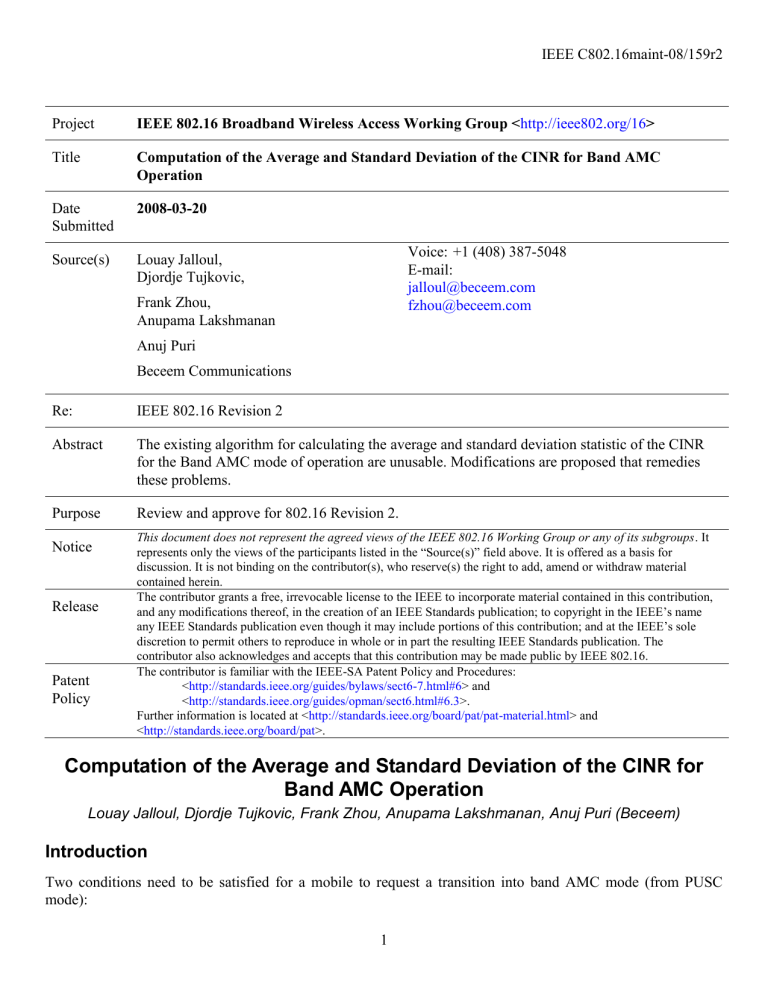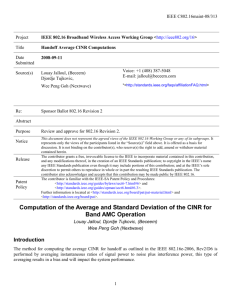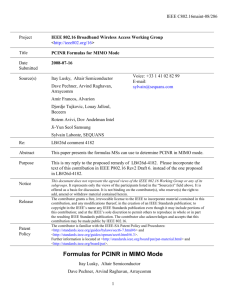IEEE C802.16maint-08/159r2 Project Title

IEEE C802.16maint-08/159r2
Project
Title
Date
Submitted
Source(s) Louay Jalloul,
Djordje Tujkovic,
Re:
Frank Zhou,
Anupama Lakshmanan
Anuj Puri
Beceem Communications
IEEE 802.16 Revision 2
Abstract
Purpose
Notice
Release
Patent
Policy
IEEE 802.16 Broadband Wireless Access Working Group < http://ieee802.org/16 >
Computation of the Average and Standard Deviation of the CINR for Band AMC
Operation
2008-03-20
Voice: +1 (408) 387-5048
E-mail: jalloul@beceem.com
fzhou@beceem.com
The existing algorithm for calculating the average and standard deviation statistic of the CINR for the Band AMC mode of operation are unusable. Modifications are proposed that remedies these problems.
Review and approve for 802.16 Revision 2.
This document does not represent the agreed views of the IEEE 802.16 Working Group or any of its subgroups . It represents only the views of the participants listed in the “Source(s)” field above. It is offered as a basis for discussion. It is not binding on the contributor(s), who reserve(s) the right to add, amend or withdraw material contained herein.
The contributor grants a free, irrevocable license to the IEEE to incorporate material contained in this contribution, and any modifications thereof, in the creation of an IEEE Standards publication; to copyright in the IEEE’s name any IEEE Standards publication even though it may include portions of this contribution; and at the IEEE’s sole discretion to permit others to reproduce in whole or in part the resulting IEEE Standards publication. The contributor also acknowledges and accepts that this contribution may be made public by IEEE 802.16.
The contributor is familiar with the IEEE-SA Patent Policy and Procedures:
< http://standards.ieee.org/guides/bylaws/sect6-7.html#6 > and
< http://standards.ieee.org/guides/opman/sect6.html#6.3
>.
Further information is located at < http://standards.ieee.org/board/pat/pat-material.html
> and
< http://standards.ieee.org/board/pat >.
Computation of the Average and Standard Deviation of the CINR for
Band AMC Operation
Louay Jalloul, Djordje Tujkovic, Frank Zhou, Anupama Lakshmanan, Anuj Puri (Beceem)
Introduction
Two conditions need to be satisfied for a mobile to request a transition into band AMC mode (from PUSC mode):
1
IEEE C802.16maint-08/159r2 i.
The average CINR of the whole bandwidth should be larger than the band AMC entry average CINR for at least band AMC allocation timer frames. ii.
The maximum of the standard deviation of the individual band’s CINR measurements should be lower than the band AMC allocation threshold (σ
MAX
) for at least band AMC allocation timer frames.
The method for computing the average CINR as outlined in the IEEE 802.16-2006, Rev2/D3 is performed by averaging instantaneous ratios of signal power to noise plus interference power, this type of averaging results in a bias and will impact condition (i) above.
Further, the method for computing the standard deviation as outlined in IEEE P802.16 Rev2/D3 specification is performed using linear values of CINR moments and not decibel values of the CINR moments. This causes a problem when checking for condition (ii) above.
Problem Definition for Average CINR
The IEEE 802.16 standard specifies that mean CINR shall be derived from the multiplicity of single messages using the equation in which the mean CINR is obtained as the IIR average of instantaneous CINRs. This suggests that mean CINR should be derived as the expectation of instantaneous ratios of signal power and noise plus interference power (expectation of ratios, EOR) as given by
This type of averaging over fading channels deviates from the true signal-to-noise ratio defined as the mean
(expectation) of signal divided by the mean (expectation) of interference power (ratio of expectations, ROE).
The amount of bias from true CINR is not constant but depends on statistics of desired and interfering BS channels as shown in Appendix. Consequently, decisions for transition into band AMC mode will not be consistent for users throughout the cell which will affect the system performance.
while interfering BS channel is assumed to be frequency flat. Subscriber is moving with 60km/h. The method currently suggested in standard would result in CINR bias of as much as 8dB. Figure also depicts the performance for averaging logarithmic values of instantaneous ratios of signal power to noise plus interference power (denoted as EO[dB]R in figure). This method is often discussed as an alternative method to alleviate problems with standard defined metric for average SINR. As seen from Figure 1a (also shown analytically in
Appendix), this method suffers from similar problem with bias. In turn, the ROE proposed here results in accurate averaging without bias.
2
IEEE C802.16maint-08/159r2
SINR=0dB, Serv BS Veh A, Interf BS Freq flat
10
8
14
12
6
4
2
0
EOR[dB]
ROE[dB]
EO[dB]R
-2
0 500 1000 1500
# frames
Figure 1: Average SINR for different averaging methods
Problem Definition for Standard Deviation of CINR
In the current version of the standard, the standard deviation is to be computed in the following manner: i.
Compute the 1 st moment of CINR as: ii.
Compute the 2 nd moment of CINR and the standard deviation as:
3
IEEE C802.16maint-08/159r2
The problem with the above method is that difficult to use a single value of σ
MAX
ˆ
CINR
and ˆ 2
CINR are not computed as decibel values. This makes it
for a range of CINR values as shown below:
Let xn, k = ( + ε) be the mean CINR for frame n in band k. Assume
n k
n k
(1
)
Let σ
ˆ[
MAX
ˆ[ n
1, ] n
k
ˆ[ n
k
ˆ[ n
k
ˆ[ n
k
ˆ[ n
k
2
[ n
1 , k ]
2
[ n
1 , k ] . Then:
Thus in the current standard, σ
MAX
needs to be high before an MS with high CINR will request AMC:
High σ
MAX
low CINR users that cannot effectively use AMC are more likely to request AMC (AMC helps deserving low CINR users)
Given a mix of users with different speeds, it becomes difficult to identify users that can effectively use AMC and users that cannot effectively use AMC.
4
IEEE C802.16maint-08/159r2
20
15
10
5
35
30
25 mean CINR
Boundary of allowed CINR variation
PUSC
AMC eligible
PUSC
0
0 5 10 15
CINR (dB)
20 25 30
Figure 2: Allowed CINR variation for band AMC operation
shows the allowed CINR variation for an MS to be able to request band
AMC transition. The red line is the CINR value and the bounding blue lines are the allowed CINR variation.
The blue line is 3σ
MAX, linear
of the red line. Assuming a Gaussian CINR distribution, this should capture more than 99.9% of the expected distribution of the CINR. It is clear from this figure that low CINR users have a larger allowed variation as compared to high CINR users.
Proposed Resolution for Average CINR
The average CINR to be used in validating the first criteria for requesting transition into BAMC zone should be calculated as a dB value of the IIR averaged received Signal power divided by the IIR averaged Noise plus
Interference power, as shown below
CINR
RSSI (1)
RSSI
Noise
CINR dB
10 log
10
CINR
( i )
is the average RSSI of the desired BS and
RSSI where
RSSI
is the average RSSI of the j th interfering
BS. The exact method for calculating individual BS RSSIs or sum of interfering BS RSSIs is implementation specific.
5
(2)
IEEE C802.16maint-08/159r2
Whenever measurement is missing in a given frame, average values of received Signal power and Noise plus
Interference power are repeated from the previous frame. The RSSI and IIR averaged received signal and IIR averaged Noise plus interference power for calculating the average CINR should be calculated from multiplicity of single messages as
RSSI
[ k ]
RSSI
[ k
1 ]
avg
RSSI
RSSI [
[ 0 k ]
],
RSSI
[ k
1 ]
g [ k ], k k
0
0
(3) where
RSSI measured in frame k g [ k ]
1 ,
0 , RSSI not measured in frame k
Whenever the average CINR dB
of the whole bandwidth as defined in (2) is larger than the band AMC entry average CINR for at least band AMC allocation timer frames, the first condition to request a transition into band
AMC mode (from PUSC mode) is considered to be met.
Modify the current text in Rev2_D3, Section 8.4.11.3, page 1001 :
To the following:
ˆ
CINR dB
RSSI
RSSI
Noise and
RSSI
is the RSSI of the i-th BS which is given by
RSSI
RSSI
[ k
avg
RSSI [0],
RSSI [ ]
RSSI
[ k
1]
g k k k
0
0
6
(158)
where g [ k ]
1 ,
0 ,
RSSI
RSSI not measured measured in in frame frame k k
Proposed Resolution Standard Deviation of CINR
The proposed solution is to compute ˆ
CINR
[ ]
and i.
Compute the 1 st moment of CINR as:
[ ]
CINR
(1-
dB
[0] avg
)
ˆ
2
CINR
avg
CINR [ ] dB as decibel values: k k
where: CINR dB k
CINR linear k ii.
Compute the 2 nd moment of CINR and the standard deviation as:
ˆ 2
[ ]
( CINR dB
(1-
[0]) 2
avg
)
ˆ 2
,
[ k
avg
( CINR dB
[ ]) 2
and standard deviation as:
ˆ ˆ 2
ˆ 2 k k
IEEE C802.16maint-08/159r2
Ошибка! Источник ссылки не найден.
illustrates how the proposed solution fixes the problem described earlier
7
IEEE C802.16maint-08/159r2
20
15
10
35
30
25
5
0
0 mean CINR boundary of allowed CINR variation
PUSC
AMC eligible
5 10 15
CINR (dB)
PUSC
20 25
Figure 3: Illustration of proposed solution
30
8
IEEE C802.16maint-08/159r2
Appendix
Expectation of ratios vs ratio of expectations
The ratio of the expected signal and expected interference power (ROE) and expectation of instantaneous ratios of signal and interference powers (EOR) are given as
ROE
CINR
E
E
(4)
EOR
E
S
I
(5)
The ROE in (4) is also marked as the true CINR which averages out fast fading variations without changing the relative ratio of individual mean BS powers. Let us zoom into EOR:
EOR
s i p
S , I
( s , i ) dsdi
sp
S
( s ) ds
E
1 i i
1 p
I
( i ) di p
I
( i ) di
(6) where the last two steps stem from fact that signal and interference power are independent. The interference power is a chi-squared random variable with M degrees of freedom. Hence, the probability density function
(PDF) p ( i )
I of the inverse of interference power is given by the so called inverse chi-squared distribution p
I
( i ; M )
2
M / 2
( M / 2 ) i
M / 2
1 e
1 /( 2 i ) (7) whose mean is given by
1 p
I
( i , M ) di
i E
1
M
M
2
(8)
We finaly write the EOR as
9
IEEE C802.16maint-08/159r2
EOR
E
E
M
M
2
CINR
M
M
2
(9)
Notice that for flat fading channel, where the number of degrees of freedom is equal to M =2, the EOR grows to infinity
EOR
M
2
(10)
Applying the IIR filter, which acts as a moving average filter will to some extent, bound the bias in EOR mean
CINR. Nevertheless, the impact from bias will be still rather dramatic in practice.
As an alternative method to ROE filtering, another method denoted hereafter by expectation of dB ratio
(EOdBR) is often discussed. In this method the dB instead of linear value of instantaneous CINR measurement is passed through IIR filter in section 8.4.11.3
EOdBR
E log
I
0
E (
2
E { I }
)
1
M s
S
I
(6)
Without loss of generality, let us assume that instantaneous signal and inference powers can be represented as the product of constant representing the mean power and the random chi-square variable with unit power with given number of degrees of freedom. That is
S
S
0
2
M s (7)
I
I
0
2
M
I with
S
0
E { S }
(8)
E (
2
M
I
)
1 where M
S
and M
I
denote the number of degrees of freedom in signal and interference channels, respectively. Let us zoom into EOdBR from (6)
1
0
IEEE C802.16maint-08/159r2
EOdBR
E
E
log( log( S
0
S
)
)
E
log( log(
I
2
M
)
S
)
E
log( I
0
)
E
log(
2
M
I
)
E
log
S
0
I
0
E
log(
2
M
S
)
E
log(
2
M
I
)
(9)
log
S
0
I
0
M
S
, M
I
With assumptions in (7) and (8), the dB value of true CINR (ROE), denoted hereafter by ROEdB, is given by
ROEdB
log
E
E
(10)
log
S
0
I
0
Comparing (9) and (10), it is apparent that in general EOdBR has bias compared to true CINR (ROEdB). The sign and value of bias depends on the number of degrees of freedom in signal and interference channel. Only in the special case when M
S
and M
I are equal, the bias term is equal to zero.
Therefore, the ROE represents the only liable bias free solution.
1
1


